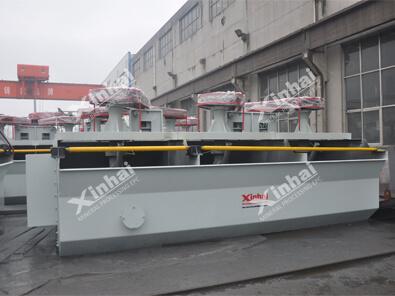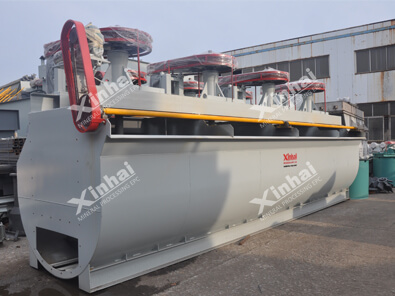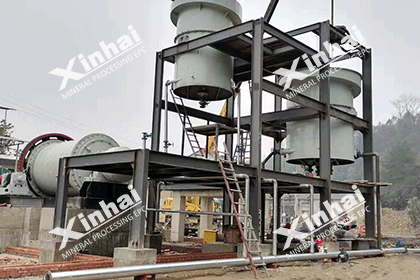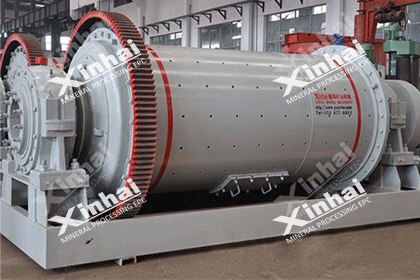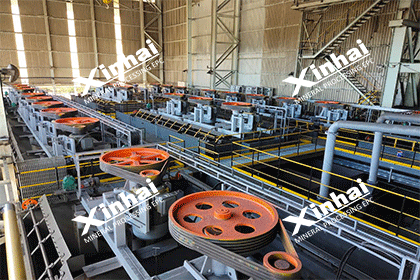How is Copper Extracted from Its Ore?
 Shirley
Shirley
 Feb 22, 2022
Feb 22, 2022
 2761
2761
If you want to know more details about equipment, solutions, etc, please click the button below for free consultation, or leave your requirements!
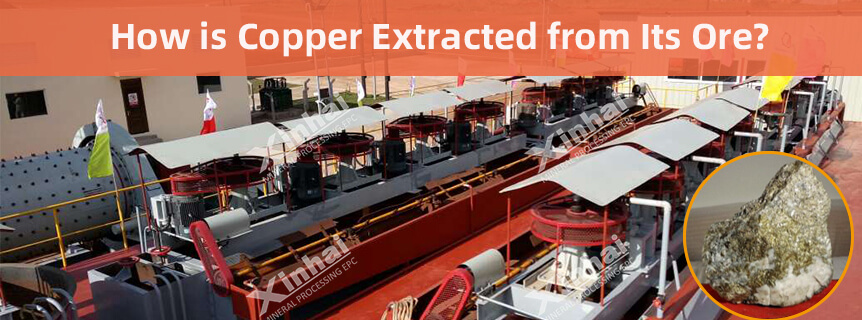
According to the different physicochemical properties of copper ores, it often apply single or several combined separation process technology to separate valuable minerals and gangue minerals as much as possible. It removes or reduces the harmful impurities, and acquires copper concentrates for smelting or other industrial needs. Among them, the main copper extraction methods are copper flotation and leaching methods.
01 Copper Flotation Method
Back(1) Single Copper Sulfide Flotation Process
The mineral composition of single copper sulfide is simple. The copper minerals are mainly chalcopyrite, chalcocite, bornite, covellite, and little copper oxide minerals. The gangue minerals are different from deposit types, including quartz, calcspar, feldspar, dolomite, sericite, chlorite, etc. Because of the large difference between copper and gangue minerals, flotation is the common processing method. According to different occurrence, the structures and constitutions change a lot, which causes the different difficulties of monomer dissociation. The grinding fineness is a key point influencing copper sulfide flotation indexes. Commonly, copper sulfide flotation technology includes the following three:
One-stage Grinding – Flotation Methods
This processing technology is suitable for processing copper minerals with coarse and uniform grain size, loose copper minerals and gangues, and ores with smooth and flat contact edges. Generally, the grinding fineness for raw ore is 50-60% under 200 mesh. The copper minerals monomer dissociates then. Through rough flotation, scavenging and one-three stage concentrating, good flotation indexes can be acquired. This flotation flow is simple with low processing costs.
One-stage Grinding – Flotation – Rough Concentrates Regrinding Processing Flow
This processing flow is commonly suitable for single copper sulfide ore of porphyry copper ore or copper molybdenum ore. According to the copper mineral embedding characteristics, the raw ores are grinded to 50-70% under 200 meshes. A large number of tailings are discarded in roughing and scavenging. Through the roughing concentrates grinding, the copper concentrates can be required two or three times of concentrating. The first flotation tailings in flotation cycle can be discarded in scavenging, or return to roughing cycle after thickening. Some copper processing plants would deal with middlings after regrinding. If the grade of raw ore is low with a large capacity, this kind of process flow brings better efforts. Besides, due to the regrinding of coarse concentrates with fine particle size, monomer dissociation degree of copper minerals and gangue minerals is better, and higher quality of flotation concentrates.
Two-stage Grinding – Two-stage (or one-stage) Flotation Process
For uneven thickness embedding copper ores, it is necessary to grind ores with fineness under 200 meshes over 80% to dissociate most copper minerals. During this period, the two-stage grinding is better than one-stage grinding in no matter grinding efficiency or preventing over-grinding. Using two-stage grinding and two-stage flotation, after the ore is coarsely ground in the first stage, a part of the coarse-grained copper minerals can be floated to avoid excessive crushing. This part of concentrates is high in grade, which can be used as concentrates directly. It can also enter the final concentrating, or combining with concentrates after two-stage grinding and flotation and entering combining concentrating. If there are little coarse copper minerals, two-stage grinding and one-stage flotation technology flow can be used as well. Flotation recycling uses scavenging and two to three times of concentrating. The middlings usually returns to the second grinding cycling. Relatively speaking, it has higher costs in technology flow and is more complex in equipment configuration and production operation.
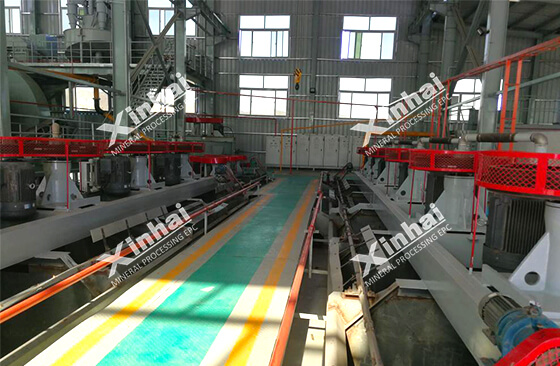
Copper extraction plant in Pakistan
(2) Polymetallic Copper Sulfide Flotation
Polymetallic copper sulfide ore has multiple copper minerals and also pyrite, galenite, blende, and other minerals. The mineral’s composition and structure are more complex. The minerals are closely related to each other. Basis on the above ore characteristics, polymetallic copper sulfide flotation technology flow includes the following types:
Multistage Flotation Process
This technology flow is mainly for copper sulfide minerals containing ferric sulfide. The mineral component is simple. Therefore, multistage flotation technology flow is the common technology flow of copper sulfide flotation. The key point is copper and sulfur separation. Multistage coursing – multistage concentrating – scavenging flotation flow is commonly used, which can require good recovery effort. However, ideal processing effort is hard to gain for copper sulfide ores with a more complex composition.
Stepwise Preferential Flotation Process
The stepwise preferential flotation process is suitable for copper sulfide with a more complex composition. This copper is complex in types, mainly azurite and enargite. The key point is also at copper and sulfur separation. Because of the complex construction, conventional flotation technology can hardly require qualified copper concentrates. Different kinds of copper minerals have different floating speeds. Therefore, the copper minerals easy to float can be coarse separated, and then regrinding and middlings re-processing for copper minerals are hard to float. The copper concentrates are combining recovering, which guarantees the grade and recovery rate.
Flotation – Mixed Concentrate Separation Process
This process flow is mainly applied for low-grade copper sulfur ore with a complex symbiotic relationship with chalcopyrite, blende, galena. After coarse grinding and coarse separation abandoning most gangue minerals, copper-lead-zinc concentrates can be required. Then the concentrates can be separated treated to require single copper minerals. This process flow can separately recover copper, lead and zinc minerals. However, it is also easy to cause the incomplete separation of mixed concentrates.
Equal Floatable Flotation Process
This processing flow separates copper, lead, zinc and other metal minerals due to the floating speed. Fast floating minerals and slow floating minerals are separated floated. It can eliminate the influence of residual agents, reducing agent amount. However, the process is more complex with a long consumption period and more grinding equipment.
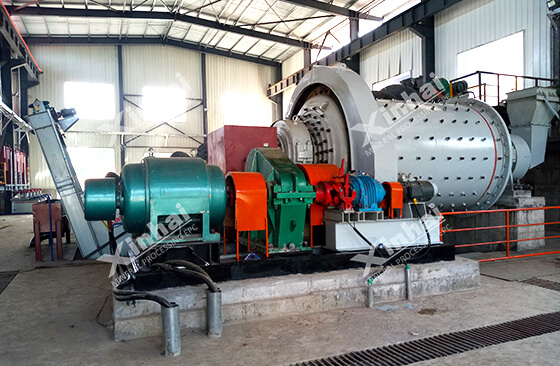
Copper extraction plant in Laos
(3) Copper Oxide Direct Flotation
Copper oxide direct flotation method is the direct flotation method with advanced fatty acids, their soaps and amine collectors without pre-vulcanization. It mainly includes fatty acid flotation method, amine collector flotation method, chelating agent–neutral oil flotation method, and emulsion flotation method. It is suitable for simple structure copper oxide that is single in a property.
Fatty Acid Flotation Method
It uses fatty acids and their soaps as collectors. Gangue depressant water glass, phosphate, and pulp inhibitor sodium carbonate are added as well during flotation. Fatty acids and their soaps can float malachite and azurite. Fatty acid with different hydrocarbon chains can float malachite. As long as the hydrocarbon chain is long enough, its capture capacity is very strong. Fatty acid flotation method is suitable for copper oxide minerals that gangue minerals are not carbonates. If there are a large amount of iron and manganese minerals, the flotation indexes will get worse. The mine mud will cause fatty acid failure.
Amine Collector Flotation Method
It is also called cationic collector flotation method. It is the common flotation method for non-ferrous metal oxidized ores. Amines are used as collectors for flotation, which are widely used in malachite, chalcopyrite and chlorite in copper mines. Amine collectors are selective for copper oxide, because amines also have a collecting effect on many gangues. Before separation, it is necessary to remove mud in advance, but for argillaceous copper oxide, pre-deslimation will lead to copper loss. Therefore, the premise of selecting amine flotation method is the selection and control of inhibitors in gangue minerals. At present, the commonly used gangue inhibitors include seaweed powder, ligninate (or cellulose lignin sulfonate) and polyacrylic acid.
Chelating agent – Neutral Oil Flotation Method
This method is to complete flotation with chelating agent and neutral oil. It is suitable for refractory copper oxide ore. It not only has good selectivity and collection effect, but also can guarantee separation indexes and reduce reagent consumption. And chelating agent has selective inhibition. However, the cost of chelating is high. The chelating agents currently used are octyl substituted basic dyes malachite green, potassium octyl hydroxamic acid, benzotriazole and neutral oil emulsifiers, N-substituted imine diacetates, polyamines and organic halides.
Emulsion Flotation Method
The flotation method is mainly to sulfurize copper oxide minerals first, and then add copper complex agent to create a stable surface of lipophilic minerals, and then use neutral oil emulsion to cover the surface of minerals, resulting in a strong hydrophobic floating state. In this way, minerals can be firmly attached to the bubble and complete the separation.
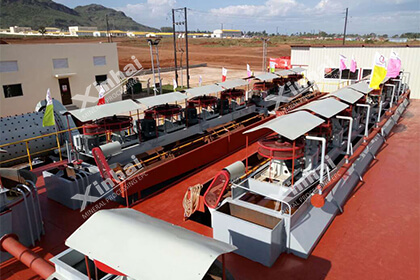
Copper extraction plant in Ghana
(4) Copper Oxide Sulfide Flotation
Copper oxide sulfide flotation mainly includes ordinary sulfide flotation and hydrothermal sulfide flotation.
Ordinary Sulfide Flotation Method
The flotation method first sulfurizes copper oxide minerals (using sodium sulfide or other vulcanizing agents), and then uses advanced xanthate collectors for flotation operations. In the vulcanization operation, the lower the pulp pH value is, the faster the vulcanization operation is, and the sulfides such as sodium sulfide are easier to be vulcanized. Sulfide flotation is mainly used to treat carbonates with copper as the main copper oxide minerals, such as malachite, chalcopyrite and other minerals, or hematite. However, special treatment is needed for malachite silicate, otherwise the sulfide effect is poor or even cannot be vulcanized.
Hydrothermal Sulfide Flotation Method
The flotation method extends the conventional sulfide flotation method. The sulfide operation is carried out under hot pressing conditions, so that sulfur reacts with copper oxide under hot pressing conditions to obtain stable and easy-to-select artificial copper sulfide minerals. The same mineral is recovered by flotation of copper sulfide in warm water. This method strengthens the pretreatment-presulfidation process of ore, but this process requires high temperature, large fuel consumption and long curing time.
(5) Mixed-type Copper Flotation
For this kind of ore, the sulfide flotation method is generally used in Xinhai solution, there are two kinds of technological processes. In one way, copper sulfide minerals are selected first, and then copper oxide minerals are selected after tailings are sulfided. The other is the simultaneous flotation of copper oxide and copper sulfide after sulfide. The process conditions of simultaneous flotation of copper oxide minerals and copper sulfide minerals are basically the same as that of copper oxide ore. The dosage of sodium sulfide and collector should be reduced with the decrease of copper oxide mineral content in ore. When copper oxide minerals are floated after vulcanization, copper sulfide minerals can float well.
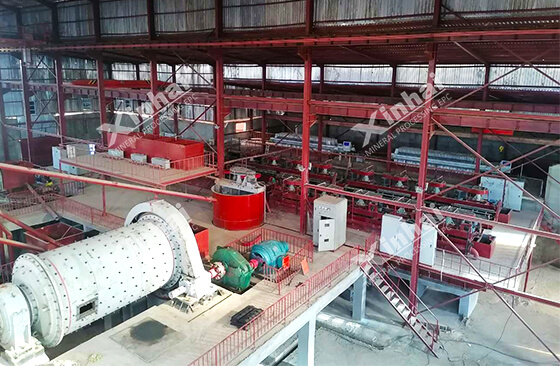
Copper extraction plant in Morocco
2. Copper Leaching Process
(1) Heap Leaching Process
The heap leaching process is to place the broken copper oxide ore (mixed part of copper sulfide ore) on the leaching pad and spray a strong acid solution to let it penetrate into the broken gravel. Over time, copper in the crushed stone is leached into the solution to become precious liquid, which is collected and pumped to the solvent extraction equipment for further purification. The heap leaching process is widely used in the leaching of low copper surface ore and waste ore.
(2) Pool Leaching Process
It is a leaching method commonly used in early copper hydrometallurgy. In the leaching tank, use a more concentrated sulfuric acid solution to leaching oxide ore containing 1-2% copper (particle size -1cm). Due to the high copper concentration in the leaching solution, it can be directly used for copper electroplating.
(3) In-situ Leaching Process
In-situ leaching can be used to treat residual ores of old ores or unexploited oxidized and lean copper ores. For abandoned mines or uneconomic copper mines recovered by other processes, in-situ leaching process has great potential. During in-situ leaching, the general well spacing is 30 × 30cm (or 15 × 7.5m), the borehole diameter is 15-25cm, the hole has a plastic pipe straight through the ore body. The leaching agent flows into the ore body along the plastic pipe, and the leaching solution is pumped back to the ground from the bottom of the ore body.
(4) Agitation Leaching Process
The copper agitation leaching process carries out in the leaching tank with agitation leaching devices. Leaching fine particles (-75um 90%) of oxidized ore or sulfide ore with concentrated sulfuric acid solution. The main leaching methods are air stirring and mechanical stirring.
Due to the small feed size and sufficient stirring, the stirring leaching rate is faster and the leaching rate is higher than the pool leaching. Therefore, stirring leaching can not only treat copper ores with high grade, but also treat copper ores with low grade (Cu < 1%) such as tailings.
02To Wrap Up
BackThe above teach you how is copper extracted from its ore. If you have other questions, please leave your message or contact our online service, we will contact you soon.
 +86 183 3575 8886
+86 183 3575 8886 pinklaurabao@gmail.com
pinklaurabao@gmail.com




 Message
Message Chat Now
Chat Now


